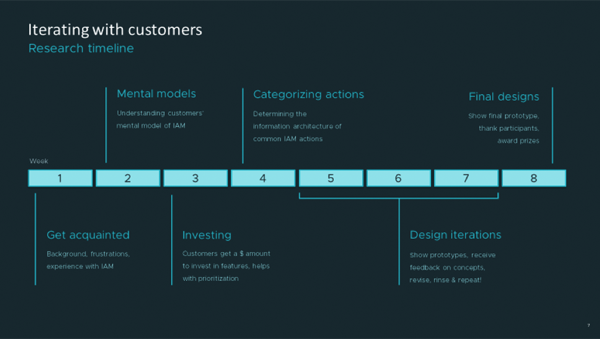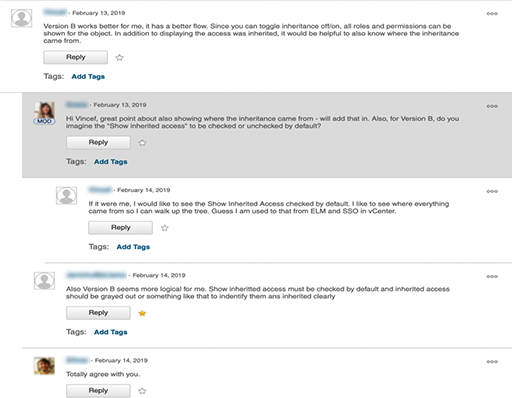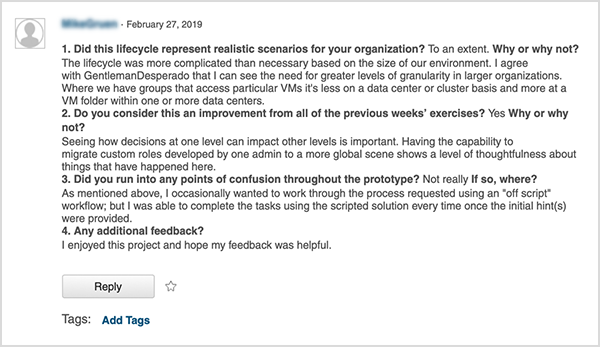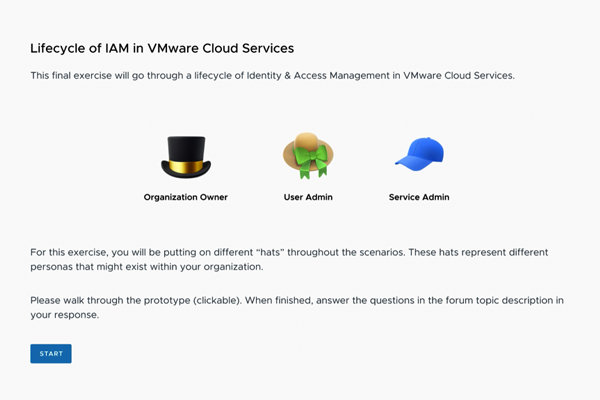With an open dialogue with customers, companies can accelerate and de-risk product innovation by gathering insights at every step of the product development cycle. With the Inner Circle, an online community of VMware customers and partners that facilitates rapid-cycle research, VMware product teams can improve product innovation while building customer satisfaction and loyalty along the way.
Customer feedback is crucial to any product development process, but can be difficult to obtain for organizations who struggle to engage with hard-to-reach audiences, like IT decision makers at enterprise companies. Getting ongoing and open access to zero-party data from the right customers at the right time can be a seemingly impossible task. And, depending on how organizations collect that insight, they either strengthen or stress the relationship with their customers.
Companies with customer-centric insight teams have begun partnering with their customers, improving the feedback process for both the customer and the company. Through a repeatable customer engagement model, teams at VMware like the VMware Cloud Services team are using the feedback experience to strengthen their relationship with their customers—and transforming them into brand advocates along the way.
“We see customers as partners, not resources from which data can be extracted.”
—Senior Research Manager, VMware
Product Designers on the VMware Cloud Services team wanted to innovate and improve the design of their product through a series of agile iterations over the course of eight weeks. They knew one of their biggest challenges would be gathering enough customer feedback on each design iteration to validate their decisions. Additionally, they wanted the same customers to provide feedback every week so that customers can see progress week by week and feel like valued members of a team.
By using a feedback model that collects continuous insights from customers, they planned to incorporate the insights back into their projects every week to develop powerful learnings. But for a B2B company whose customers are busy IT professionals, getting their feedback was no easy task.
“In our industry, you can’t get people to take surveys. An IT decision maker is not spending her time filling out ad hoc survey requests. No amount of rewards, bonuses, or pats on the back incentivize these people to provide feedback.”
—Senior Research Manager, VMware
To solve this problem, VMware turned to their Inner Circle. The Inner Circle is an insight community of VMware customers and partners who want to help shape VMware decisions. These individuals were originally recruited via a mass mailing, supplemented with later ad hoc efforts over the years. The members of their Inner Circle are richly profiled, have opted-in to provide feedback to the company, and are highly engaged.
“We get, on average, 1–2% response rate from general population surveys and they’re very expensive. With our Inner Circle, we got at least a 25% response rate. We’re sitting on a gold mine of customer insights.”
—Senior Research Manager, VMware
Though customers are willing to give feedback, insight professionals are mindful that the relationship is two-sided. Companies are held accountable for transparent use of customer feedback, especially in this era of data privacy. However, respecting consumer privacy goes beyond just meeting new legislated minimums. It requires consent based feedback programs where customers understand exactly how their information is being used. VMware put care and attention towards educating their customers on the value their feedback had to the organization, often even citing direct changes influenced by the customer.
“If customers spend their valuable time providing feedback, we need to show them the value of their input.”
—Senior Research Manager, VMware
Through this continuous engagement model, customers were able to see the impact their feedback had and they began to feel a sense of ownership over the product.
Here’s What They Did:
The VMware Cloud Services team set out with a clear goal: find at least 10 customers to be a part of their Design Team, a targeted group of customers selected from their Inner Circle. This team would provide feedback on a weekly basis, for eight weeks, to help improve the design and user experience of the Identity and Access Management process within VMware Cloud Services. They wanted continuous immersion with the same people—not just a one-off experience.
“We constantly need to be in contact with our customers. We connect product designers directly to consumers to shorten and improve product innovation.”
—Senior Research Manager, VMware
They began by reviewing the profiles of Inner Circle customers, seeking a group whose job functions included Identity and Access Management. Once they narrowed down their ideal audience of approximately 3,000 customers, they sent out the call to join the Design Team and help influence VMware Cloud Services. Despite what they thought was an ambitious goal of 10 customers, 135 customers signed up.
“It changed the way VMware operates. Instead of burdening customers by asking for feedback and rewarding them, customers are banging down our door to give feedback because they feel heard and valued.”
—Senior Research Manager, VMware
Here’s How They Did It:
Planning Weekly Design Exercises
The research effort was successful because the weekly design activities were carefully planned to be engaging and interesting.

Each week, VMware sent an email reminder with a link to a Discussion Forum. Most participants would respond soon after they got the email, and came to expect it. The UX team joined the forum so they could have online conversations with customers in real time.

Week 1: Getting Acquainted
For the first four weeks, VMware focused on getting acquainted with the customers. This meant understanding their background, experiences, and even frustrations with the current product experiences.
- Sample question posed to the community: What are your biggest frustrations when managing access and roles for users and groups?
Week 2: Mental Models
Then they moved to activities focused on understanding how the customer’s brain works. Customers were shown three mental models and asked to explain why they preferred one model over another.
Here are two examples of Mental Models:

Week 3: Investing
For the following week, each customer was given a dollar amount to invest in features. The end result was a detailed outline of how each customer prioritized and valued each product feature. This gave the team crucial information on how to prioritize features and where to focus their design efforts.
Week 4: Categorizing Actions
For Week 4, they wanted to determine the information architecture of common product actions. For example, they asked customers how they categorize features in accordance to platform versus service.
Week 5–7: Design Iterations
These weeks focused on showing the customers design prototypes and getting feedback on them. This was where customers and VMware truly solidified their partnership, working in tandem to iterate on design concepts over three weeks.
They were able to pivot designs in real time, changing course based on the feedback they had received the previous week. It was fast paced, agile development based on customer insights. By making modifications each week, customers were able to immediately see the impact of their feedback from the previous week.
Customer Feedback Sample

Week 8: Final Design
After three weeks of agile iterations, the team was able to share back the final design prototype with their participants. VMware now had a high-value, customer-validated prototype they knew customers would love. Now it was time to communicate the value back to the customers.

They ended the eight-week design process by thanking participants and awarding prizes to the most engaged members of the Design Team. Despite the organization giving away prizes for the most committed customers, it wasn’t the prizes that the customers felt were the highest value-add part of the experience.
Customers Said:
“Offer more of them :-) But, seriously, perhaps a time to meet online to brainstorm or whiteboard together. Maybe interactive sessions between the members or members and staff.”
"The Design Teams are fantastic. Very helpful, attentive and do a magnificent job. I am very happy to contribute to the product development process.”
“This is a great idea and I look forward to more opportunities to offer feedback in a focus group like this... I also would like to see a summary of responses and graph of votes after a week's activities so you can see the leanings of the larger group… Finally, it would be very nice to have more feedback and interaction with the VMware Inner Circle administrators.”
The value to customers was being able to influence the product development process and help VMware create better products, products that would make their day-to-day lives easier.
Insights & Impact
For the team, this partnership with customers heavily impacted the product roadmap. Before they began this research effort, they needed direction on what to focus on. Eight weeks later, they had insight into which product updates they needed to make and a clear view of how they would prioritize their product development efforts in the months to come. VMware accelerated their product innovation process by shortening the customer feedback loop with the Design Team. And, because their efforts were customer validated, they were able to de-risk product decisions and go to market confident their new launch would be well received by customers.
They also learned more about their customers that they could share with the rest of the organization. Two key takeaways from the initiative were:
- Users want multiple ways to accomplish tasks quickly and to accommodate different ways of thinking.
- Users want centralization across products.
It helped them shift the conversation from a product-led to an experience-led effort. Their product has a heavy technology component, so this research helped validate the engineering efforts by use cases and focus on the specific areas they wanted to tackle in their upcoming implementation.
Most importantly, the biggest value uncovered from this initiative was that the customers felt they had a stake in this project and a sense of ownership over the product. Because of that constant iteration, VMware built a partnership with the customers and made them feel valued.
“When I can get maybe 2% engagement from people who take a survey from anyone in the world, but we get 25% of customers… Now go two levels beyond that and realize this is something customers actually enjoy. It turns it from a bug to a feature and it makes the relationship with our company stronger.”
—Senior Research Manager, VMware
Ready to transform your customers into design partners?






